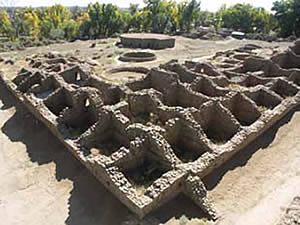
NPS Photo
Near Aztec, New Mexico over 1,000 years ago, ancestral Pueblo people constructed a large planned community that served their society for over two centuries. Aztec Ruins National Monument preserves the remains of this well planned community, which is the largest ancestral Pueblo community in the Animas River Valley. While the ancestral Pueblo people are responsible for the construction of this site, the ruins received their name when early European settlers mistakenly attributed the ruins to the Aztecs of Mexico. A visit to the park provides not only a glimpse into the lives of ancestral Pueblo people but also a place to connect with the cultural heritage of Native Americans today.
Around the late 1000s, ancestral Pueblo began planning and constructing what is now Aztec Ruins National Monument. The ancestral Pueblo probably chose this area for its location in the Animas River Valley. With its close proximity to the Animas River, early farmers could take advantage of the constant water supply. These factors likely provided the people with a reliable source of food, which possibly allowed them the ability to settle in a single location. Built on and below a terrace overlooking the river, the planned community would ultimately have many large and small public structures, earthworks, ceremonial buildings, residential pueblos, and roads.
Excavation of the site of the community revealed artifacts such as food remains, stone and wood tools, cotton and feather clothing, fiber sandals, and jewelry made of turquoise and shells. Visitors can see the remnants of many of the structures and view the artifacts in the visitor center’s museum.
This extensive planned community likely served as a trade, ceremonial, and administrative center for many of the scattered communities associated with Chaco Canyon. Chaco Canyon is the site of a major ancestral Pueblo community to the south of the Aztec Ruins, which exhibited great influence over much of this part of New Mexico between 850 A.D. and 1130 A.D. The Chaco culture, including its architectural, ceramic, and ceremonial styles, strongly influenced the early inhabitants and initial builders of Aztec. The Aztec Ruins community may have become a center in its own right by 1100, when Chaco’s regional influence began to fade.
Aztec was a bustling community for over two centuries, and its planned layout reveals that the initial ancestral Pueblo builders conceived of a grand design for their community. When the building ceased in the late 1200s, the community consisted of several great houses, great kivas (a kiva is a Hopi word meaning “ceremonial chamber”), small residential pueblos, earthworks, roads, and tri-walled kivas. The structures and landscapes were all constructed and modified to give continuity and formality to the overall essence of the community. The builders used local adobe mud for the structures’ walls. For roofing, they used cottonwood, pinyon pine, juniper, pine, spruce, Douglas fir, and aspen (which they obtained from mountains many miles away).
The great houses within the West and East Ruins are large public buildings with many connected rooms that surround a central plaza. The West Ruin, which visitors can explore, has at least 400 interconnected rooms of three stories; some of its walls even reach 30 feet. Visitors can still see the original pine, spruce, and aspen beams that the ancestral Pueblos used in the construction of this great house and the excavated and reconstructed Great Kiva of the West Ruin Plaza. Ancestral Pueblos used the Great Kiva for community wide ceremonial events.
Only a short walk from the West Ruin and Great Kiva is the unique Hubbard Site. The Hubbard Site has one of only a handful of tri-walled structures in the Southwest, which most likely dates from the early 1100s. The Hubbard Site structure has three concentric walls and is divided into 22 rooms surrounding a kiva. Its functions, other than for ceremonial purposes, remain unclear. A self-guided walking tour leads to the West Ruin, the Great Kiva, smaller kivas, the West Ruin Plaza, and the Hubbard Site. The other ruins, including Mound F, Mound A, East Ruin, and the Earl Morris Ruin, are closed to the public.
By about 1300 A.D., the ancestral Pueblo people left this region and dispersed southeast, south, and west. A combination of factors such as drought, climate changes, depletion of natural resources, and social changes likely influenced the ancestral Puebloans' decision to leave their well planned community in order to establish their lives elsewhere.
While the ancestral Puebloans left this area by about 1300 A.D., many Southwestern American Indians maintain a deep connection with this place through their traditions and ceremonies. Aztec Ruins National Monument connects modern people with a distinct civilization that inhabited the Aztec, New Mexico area over 1,000 years ago.
Aztec Ruins National Monument, a unit of the National Park System, is located one mile north of Aztec, NM, near the junction of U.S. 550 and NM 516. The Monument is open daily, but closed on Thanksgiving, Christmas, and New Years Day. For more information about hours and operations, visit the National Park Service Aztec Ruins National Monument website or call 505-334-6174.
Aztec Ruins National Monument is featured in the National Park Service American Southwest Travel Itinerary and has been documented by the National Park Service’s Historic American Buildings Survey.
Last updated: November 8, 2017
